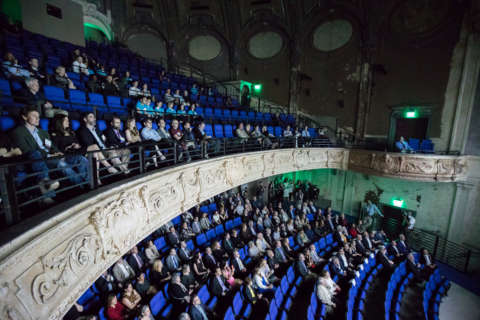WASHINGTON — Tchaikovsky’s “Sleeping Beauty” is one of the most iconic ballets of all time.
This week only, The Washington Ballet stages the classic production at the Kennedy Center.
“It really is the pinnacle of all classical ballets,” dancer Nicholas Cowden told WTOP. “Most companies that take it on have 75 dancers in their company, versus we have about 30. Really the scale is smaller, but you’re not losing any of the grandeur or any of the music. … Ours is more like a jewelry box production and very tailored and custom to our production.”
First staged in 1889, the story opens with the christening of Princess Aurora where she is blessed by various magical fairies. When the evil fairy Carabosse crashes the party, jealous that she wasn’t invited, she puts a curse on Aurora so that on her 16th birthday she will prick her finger on a spindle and die. Thankfully, the Lilac Fairy softens the spell so that instead of dying she will send the whole kingdom to sleep for 100 years until Aurora receives true love’s kiss.
“The prologue is the christening,” Cowden said. “Act 1 is her 16th birthday party, so at the end of Act 1 she falls asleep and pricks her finger. Then you have an intermission between Act 1 and Act 2, which is like 100 years, but it’s only 20 minutes! Then you have the hunt scene at the beginning of Act 2, which introduces the prince [with] his royalty party. From there he’s really sad, he meets the Lilac Fairy, she takes him to meet Aurora, and then at the end of Act 2 is the kiss, she’s woken up, and then Act 3 is the wedding celebration.”
Don’t expect the horns of Maleficent; Carabosse boasts a different menacing look.
“She looks very, very evil,” ballet master Ruben Martin told WTOP. “So just beware!”
“What’s awesome is that it’s neither male nor female,” dancer Jessy Dick said. “There’s both males and females playing the part, which is awesome because a female might bring another flair to the role than a male would. It’s a good contrast to the good fairy, the Lilac Fairy, so you get a good contrast between the good and the evil — and good triumphs in the end.”
The “good” is represented by four dancers rotating as Aurora: Eun Won Lee on Wednesday and Saturday nights, Katharine Barkman on Thursday night and Saturday afternoon, Maki Onuki on Friday night and Sunday afternoon, and finally Ayano Kimura on Sunday night.
“Aurora has to dance a lot,” Dick said. “Her stamina has to be crazy because she has variations in every single act. You’re not waiting around. … It’s a great combination of the stamina you need, the technical ability is very, very high, and then the music makes it all come together.”
Tchaikovsky’s music features memorable motifs for each character.
“The music is great because it tells you the whole story in itself even without the pantomime or the dancing,” Cowden said. “If you were to just go listen to the score, you could tell, ‘Oh, this is the part where the evil fairy comes in,’ or ‘this must be the part where the good fairy comes in afterward.’ It just gives it to you. It’s grand and it has motifs that are repeated throughout the ballet so you can relate. So, every time the Lilac Fairy comes, she has her theme music, and every time Carabosse comes in, she has her own music that’s evil and foreboding.”
The music is married with movements by legendary choreographer Marius Petipa.
“It was a collaboration between Petipa and Tchaikovsky, so the music and the choreography were catered to each other,” Martin said. “I think that’s one of the reasons why the themes go so well with the choreography is that they’re meant for each other with the intention that with this music comes this person and this is what we want to express with it.”
Which is the most impressive dance number?
“I would say the grand pas de deux, which I think is the pinnacle of classic ballet in the way that it carries all of the elements of the classical ballet technique,” Martin said. “The ballet technique has a vocabulary, which is what we learn when we’re three years old and develop over our career. This is what we put most of our attention on, and this ballet, specifically this pas de deux, is the extrapolation of all of those steps made into the purest choreography.”
Dick’s favorite number involves the Lilac Fairies.
“It’s very technically challenging, but we get to be in beautiful tutus behind the gorgeous Lilac Fairy, so it’s nice that her beauty rubs off on us,” Dick said. “We come in just as grand as she is because we’re behind her. … I love the fairies. There’s so much beauty and, with the music, there’s little variations, so it breaks it up. I’m really excited to see all the fairies just kill it.”
She said “Sleeping Beauty” is particularly demanding in its air-born action.
“This ballet has a lot of jumps, so you have to be very strong to make it look clear and execute the steps,” Dick said. “It’s been challenging, but a good challenge because at the end, the dance, music and choreography makes you happy. I’ll find myself in rehearsal sweating so hard, then by the end I’m smiling like, ‘Wow, I didn’t force a smile.’ It just sort of comes.”
Cowden’s favorite number is the dream sequence, or shall we say, “Once Upon a Dream.”
“It’s dreamy,” Cowden said. “When he meets her for the first time, she comes in from a vision basically and comes in from offstage and does this diagonal and he is in awe. They do this series of lifts, it’s the first time they see and touch each other, and it’s like a suspended lift center stage and they do it three times I believe. It’s just really exciting because it’s like, whoa, this is the first time that they’re seeing each other in this dream and dancing together.”
He also plays the role of Catalabutte, who’s the master of ceremonies for the kingdom.
“He’s the one who forgets to invite Carabosse!” Cowden said. “It’s really his fault, but he gets his fair share of the beating. She comes in, rips out his hair and scalps him in front of the whole party. There’s wigs and wigs and wigs in this production. … I’ll also be in the garland waltz. Dancing with a garland over your head is quintessential in any classical ballet, so that’s very exciting. Then Mazurka in Act Three, then in the hunt scene, I’ll be one of the courtiers.”
Overseeing it all is ballet master Martin, who also participates in various character roles.
“There’s a lot of character roles,” Martin said. “I will be one of Aurora’s suitors on her 16th birthday party. (Her father) introduces four suitors, who do that famous ‘Rose Adage’ with her, which is that beautiful, hard dance where she has to balance switching partners.”
The choreography plays out in a lavish visual world.
“It’s an eleganza extravaganza!” Cowden said. “The curtain opens and you just see the palace, you have courtiers entering in gorgeous dresses, capes, feathers and furs. You just have layers and layers that keep on coming out. It just creates this beautiful portrait on stage. It’s great because it starts out empty for the prologue with only one person on stage, Catalabutte, who’s asleep. … Then everyone starts arriving and you just see the picture grow in front of you and it just gets more and more luxurious as the king and queen and fairies enter.”
The costuming helps to get the performers in the mood.
“We have really elegant costumes,” Dick said. “They help the story come to life, because when you put them on, you feel elegant, you feel like you’re at the party, you feel like you’re in this grand place, so that helps us get into our characters because they are so beautiful.”
In the end, it’s the combination of all of these elements that make it a timeless classic.
“It’s the live performance aspect of combining music, dances, costumes, lighting and then bringing it all together with a beautiful story that is familiar to all,” Martin said. “I think it will be very well understood and the audience will really enjoy it. … It’s a ballet that is known for its history. It’s kind of like the creation of classical ballet within the history of the art from.”
Find more details on The Washington Ballet website. Hear the full conversation below:








